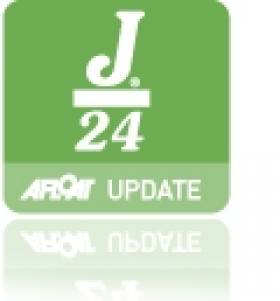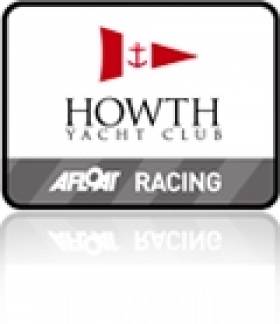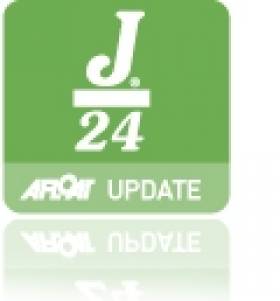Displaying items by tag: J24 Class
Ireland's Northwest With Its Uniquely Ancient Trophy Has Played a Pivotal Role in Sailing's Story
The Irish weather is no respecter of history, and sailing history in particular. Apart from the fact that it regularly appears to break meteorological records with an insouciant disregard for their significance and the patient effort that our ancestors put into noting such things in the first place, the mere fact that a date of unique importance is approaching is no guarantee whatsoever of good sailing conditions. On the contrary, the more trouble a hosting club or class association go to in preparing for a major event, the more certain we can be that the Weather Gods will rain mightily on their parade, with winds of destructive power.
So marked is this tendency – particularly in 2021, when we already don't have to seek our troubles – that there must be sailing club Honorary Sailing Secretaries who have felt tempted to pin an announcement on their public notice board to the effect that: "Absolutely Nothing Is Happening at This Club This Weekend", while secretly going ahead with planning races for all classes.
It might fool the Mysterious Might of Meteorology on one or two occasions, and in an era when every sporting happening afloat and ashore is built on a basis of desperately-sought publicity, it will probably prove a runaway winner in gathering attention.
But such sagacious hindsight is of little use to a national event last weekend which deserved to have perfect sailing conditions and much attention, but ended up with all the three days planned racing crammed into the Friday. That got a result of sorts, but Saturday and Sunday saw gales of such power that the competitors – who had come from many parts of Ireland – were glad enough to get home without their boats and towing vehicles being blown clean off the road.
 Where it all started 200 years ago – Lough Gill immediately inland of Sligo town was the scene for the first races for the Ladies Cup.
Where it all started 200 years ago – Lough Gill immediately inland of Sligo town was the scene for the first races for the Ladies Cup.
2021 is the Bicentenary of Sligo Yacht Club, which started its sailing in 1821 with races on the sheltered and microclimate-blessed waters of Lough Gill inland of the seaport town. To encourage their men in this worthy and character-building activity, the womenfolk of Sligo immediately got together to present the Ladies Cup "for the encouragement of fast sailing boats on Lough Gill". That Deed of Gift may well have had a double intention, for apart from encouraging manly sport afloat, the gradual elimination of slow boats would mean there'd be no excuse for some matelots returning home late, smelling of strong drink and the truth not in them. Even so, the hopes of achieving that in all cases were probably just about zero.
 The main hazard for the SYC Ladies Cup in its 200 years of existence is that people have tended to look after it too well, with one valuer in 1891 commenting: "The original weight was 69.5 troy ounces, from repeated cleaning it now weighs only 68 ounces, but it is in excellent condition".
The main hazard for the SYC Ladies Cup in its 200 years of existence is that people have tended to look after it too well, with one valuer in 1891 commenting: "The original weight was 69.5 troy ounces, from repeated cleaning it now weighs only 68 ounces, but it is in excellent condition".
Such innovation was part of the developing sailing scene in the northwest, and nearby in Fermanagh - where the myriad waters of Lough Erne are so all-pervasive that having a boat/yacht was often the best way to get about - by 1818 they were racing, and by 1820, and possibly earlier, Lough Erne Yacht Club was established primarily to organise yacht racing, the world's first sailing club with that specific purpose.
But whereas in the greater Lough Erne area they weren't above selling off historic silver yacht racing trophies after a bad harvest, in Sligo there seems to have been a greater reverence for such things, or for the Ladies Cup at least, and it has survived. This makes it the world's oldest continually-competed-for sailing trophy. Age-comparable bits of silverware in the Royal Cork were challenge cups for just one race – the oldest is from 1829 – and they thus remain in the trophy cupboard, while some more ancient trophies in the Royal Thames are likewise one-offs, and anyway the word is they're replicas of lost prizes.
Yet the Ladies' Cup is a true perpetual trophy, it just keeps sailing along, even if it took a few years for them to cop on that its usefulness to the sailing world would be improved by inscribing the names of each year's winner, although the first is believed to have been Owen Wynn (1755-1841) of Hazelwood, the big house of Lough Gill.
Despite the convenience to the leading local land-owner and first citizen of being able to keep his race-winning boat at the bottom of the garden, Lough Gill in high summer could be oppressively hot and heavy, and in time the Club re-focused its activity on the sea at Rosses Point, where the anchorage in the widening mouth of the Garavogue River is briskly tide-rode, but the healthy fresh sea air is served up in king-size portions.
 Sligo Yacht Club at Rosses Point, with the distinctive Ben Bulben beyond
Sligo Yacht Club at Rosses Point, with the distinctive Ben Bulben beyond
Admittedly their continuing use at Rosses Point of the Ladies Cup implies a certain cavalier disregard for its original specification in the Deed of Gift, which was clearcut for racing on Lough Gill. And certainly from time to time - being the northwest of Ireland - the winds are appropriately robust, so much so that on occasion there's an impulse to return from Rosses Point to the comparative peace of Lough Gill.
Such thoughts must have surfaced with added strength last weekend, when they hoped to celebrate the Bicentenary of the SYC Ladies Cup properly by making it the premier trophy for the 2021 J/24 Nationals. For the J/24 is popular in Sligo, and the entry list for these special nationals covered such an extensive range of clubs that they merit listing, the lineup including Royal Cork YC, Sligo YC, Carlingford SC, Mullaghmore SC, National YC, Greystones SC, Foynes YC, Wicklow SC, Lough Erne YC, Howth YC, Western YC, Bray SC, Tralee Bay SC, Mayo SC, and Lough Ree YC.
 Sailing at Rosses Point as it can be. Sligo YC is hosting the Mirror Nationals from August 20-22nd.
Sailing at Rosses Point as it can be. Sligo YC is hosting the Mirror Nationals from August 20-22nd.
So not only was the stage set, but the props for the historic drama were right on target, as the original conditions for the award of the Ladies Cup was that it be restricted to boats not more than 26ft and 3ins long. Thanks to the limiting size of the Johnson brothers' parents' garage in which the first J/24 was created in 1976, everything was compliant for making the Bicentenary Award of the Ladies Cup harmonious with history. So all that was needed was a bit of co-operation from the weather, but just to be on the safe side they made it a three-day event, with the 24-strong fleet assembled by Thursday night, and a full day's racing scheduled for Friday, August 6th.
 Atlantic horizon for J/24s off Rosses Point on the Friday
Atlantic horizon for J/24s off Rosses Point on the Friday
We're grateful to Oisin Brennan for this insider's view of an event that may merit Veterans Medals in due course:
Friday 6th of August:
With a heavy forecast looming, the competition was always under threat but all competing boats made it out to begin racing. Four races were planned with the wind steady around 15 knots and gusting 16 but continually dying off as the day went on. By the time the first race was underway the wind had dropped down to a much more manageable 8-10 knots gusting closer to 12.
The first race began with the usual chaos at the start line but no recalls. 2019 National Champions Headcase started the defence of their title well with a first with Tadgh O'Loinsigh's Janx Spirit from Tralee Bay Sailing Club in second and JP McCaldin's Il Ricco from Lough Erne Yacht Club finishing in third. The second race introduced the first recalls of the event with Jobs for the Buoys and Jevan being called back. Again Headcase took the race with Il Ricco in second and Stouche claiming third. With the wind dropping again, Stouche were one of a few boats hoping for an increase to climb further up the podium. A general recall split the fleet with some boats benefitting and others missing out on impressive starts. Even with what they considered less favourable conditions, Stouche continued their run of improving results and finished second overall once again behind Headcase. Il Ricco followed up third matching their result from the first race. The final race started with no recalls and promised to be a perfect ending to a great day of racing but huge wind shifts saw the final upwind leg become a tight reach. Headcase were not put off by this shift and finished out with four bullets. Just for the fun of it, Sligo Yacht Club finished with their best result of the competition in second, with Hard on Port from Bray taking a third place finish.
 Nervy start, restless sky – the one day of racing had to cover a host of requirements.
Nervy start, restless sky – the one day of racing had to cover a host of requirements.
Saturday 7th of August:
The day began with a two hour postponement and a general acceptance that it would be followed by a further delay. As expected there were two more official delays eventually culminating in a cancellation for the day. There was clear frustration in the fleet with a number of boats relying on the discard to improve their result. There wasn't long to be disappointed, however, with the much-anticipated dinner later that night - it was a memorable occasion, and a fantastic night was had by all.
Sunday 8th of August:
Cancellation for the day was quickly called on the Sunday with the expected heavy forecast. With no discard, results remained the same from Friday with Headcase winning both the Ladies Cup and the 2021 J24 National Championship. Il Ricco finished second and Jana following up in third.
 SYC Commodore Ken Draper (right) with the U25 Champions from Howth YC who were racing Kilcullen, they are (left to right) Philip McDowell, William Lacey, David Johnston, Sam Crawford and Jack McMahon.
SYC Commodore Ken Draper (right) with the U25 Champions from Howth YC who were racing Kilcullen, they are (left to right) Philip McDowell, William Lacey, David Johnston, Sam Crawford and Jack McMahon.
Seven under 25 teams were entered in this year's National Championships with six taking part, each funded by the Irish Cruiser Racing Association (ICRA) development programme. Kilcullen, helmed by David Johnston from Howth Yacht Club, are the J24 U25 National Champions, Jasper 2 from Foynes Yacht Club were second and Just a Minute from Greystones Sailing Club in third. Kilcullen also finished top of Silver Fleet.
Darkside, helmed by twenty-year-old Oisín Brennan of Sligo Yacht Club, sailing with a crew of family and friends ranging in age from fifteen to sixty-seven and all new to competitive sailing, finished first in the Bronze Fleet.
First in the Westerly Fleet was Conor Haughton's Jade from Wicklow Sailing Club.
Full results available here
GP 14 NATIONALS AT LOUGH ERNE
 Despite a few notable absentees, there are 40 entries for this weekend's GP14 Nationals at Lough Erne
Despite a few notable absentees, there are 40 entries for this weekend's GP14 Nationals at Lough Erne
This weekend, the focus in the history-laden northwest has switched to Lough Erne YC and the GP14 Nationals, the combination of another historic class with another historic club. In a cruel twist of fate, the problem might just be a lack of wind, but it's looking quite hopeful for some decent sailing nevertheless.
Howth J24 Nationals Attracts Top Overseas Entries
#J24 – Four top crews from the USA and Britain will be in action at the J24 National Championship at Howth this weekend as they use the event as an ideal warm-up and familiarisation session before the BMW J24 World Championship takes place on the same waters a week later.
Ian Southworth, from Royal Corinthian YC, who won the Europeans in Howth two years ago, and Bob Turner from Castle Cove SC, head the British challenge while Tony Parker from Annapolis and Keith Whittemore from Seattle are the two American skippers taking the event seriously.
Lough Erne's J-P McCaldin is the defending Irish Champion and he can expect stiff competition from multiple champion Flor O'Driscoll of the host club. Many eyes, however, will be on the performance of the Howth Under-25 Keelboat Team that has been making steady progress in the build-up to the Worlds.
A baptism of fire in the Europeans in 2011 has been followed by ongoing development and improvement, culminating in success recently in winning the J24 Eastern Championship. The team comprises Cillian Dickson, Joseph Murphy, Harry O'Reilly, Ross Darmody and Gordon Stirling.
The Irish Nationals has eight races scheduled and has attracted 20 entries from 10 different clubs.
O'Driscoll Adds J24 Easterns Title at Malahide to Season's Haul
Flor O’Driscoll, who recently retained his J24 National title and won Class 3 in the Dublin Bay Challenge, added to his season’s haul of trophies by winning the Malahide Marina-sponsored J24 Eastern Championships hosted by Malahide Yacht Club last weekend.
Something of a dress rehearsal for Irish entries in next week’s BMW J24 Europeans at Howth, the second day of the event was hampered by bad weather which prevented racing. Four good races on the Saturday however, with courses set by PRO Neil Murphy, produced competitive racing with four different race winners.
‘Hard on Port’ (Flor O’Driscoll, HYC) had a 3, 4, 1, 3 scoreline, giving him a one point advantage over second-placed ‘Crazy Horse’ (Mossy Shanahan, HYC) who edged out ‘Jibberish’ (O’Kelly/Wormald/Walsh, HYC) on count-back.
Malahide Marina J24 Eastern Championship results:
- Hard on Port Flor O’Driscoll HYC 11 points
- Crazy Horse Mossy Shanahan HYC 12 points
- Jibberish O’Kelly etc HYC 12 points
- Sayonara Murphy/Darrer HYC 14 points
- Jeb Stuart Andrew Mannion LRYC 17 points
- Scandal Brian McDowell MYC 18 points
Irish J24s practise for Europeans at Easterns
Ten Irish boats from the 41 international entries for the forthcoming BMW J24 European Championships at Howth are availing of the opportunity to practise in the same race area this weekend by competing in the J24 Eastern Championships hosted by Malahide Yacht Club and sponsored by Malahide Marina.
The event will provide six races over two days, with Neil Murphy as Principal Race Officer, and the favourite to add to his string of titles will be Flor O’Driscoll on ‘Hard on Port’, who recently retained the national championship at Lough Erne.
Among those expected to challenge that supremacy are former champion Stefan Hyde and Howth’s Fergus O’Kelly while John Murphy and Martin Darrer in the recently-acquired ‘Sayonara’ could also be in contention. The forecast for the weekend is for fresh south-westerlies which will test the fleet fully in advance of the Europeans which start on September 12th.
That event has attracted 41 entries with the latest entrant from Hungary bringing to nine the number of nations represented at that major championship. Seven of the top eight finishers in the recent UK J24 Nationals in Weymouth are travelling for the event, with a multi-national crew on ‘Reloaded’ (Mark Penfold) sailing under the US flag.
BMW J24 Europeans' Entries Reach 40-Boat Mark
Entries for the BMW J24 European Championships, to be hosted by Howth Yacht Club in two weeks’ time, have now reached the 40-boat mark from eight nations, making for an impressive fleet when racing starts on September 12th.
Irish and British entries account for 13 boats each, there are eight from Germany and two from Italy, while Holland, USA, France and Greece each have one representative.
“We are delighted with the entry level,” said Organising Committee Chairman Derek Bothwell. “Forty boats represent 200 sailors plus additional numbers with family members in Howth for the event, so it is a major occasion in every respect.” A social programme has also been arranged to keep the visitors entertained after racing each day.
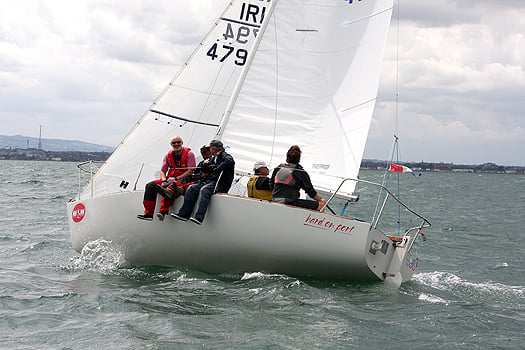
Flor O'Driscoll's Hard on Port will be sailing in Howth
The 10-race series starts on Monday 12th under the control of PRO David Lovegrove and his team, and is preceded by three days of registration and measurement and a practice race on Sunday 11th.
Irish entries will have the opportunity of extra practice on the European race track the previous weekend when neighbouring club Malahide YC hosts the J24 Eastern Championships over two days
O'Driscoll retains J24 title at Lough Erne
Flor O’Driscoll and his crew on ‘Hard on Port’ successfully defended their Irish J24 Championship title at Lough Erne last weekend but they were pushed hard all the way by the two McCaldins, Mickey and son JP, from the host club.
The eight-race championship, sponsored by Waterways Ireland, was sailed in a wide variety of wind strengths, with rain showers a feature on both days and particularly heavy conditions for the final race.
O’Driscoll, from the Royal St.George YC but sailing out of Howth this year in readiness for the forthcoming Europeans there, started slowly by his standards with a 3rd and 4th while the McCaldins took it in turns to cross the line first. He got more into his stride in race three and five with bullets but had an OCS in race 4, ultimately his discard.

Flor O'Driscoll's Hard on Port was the winner of the weekend J24 Nationals
Andrew Mannion of Lough Ree YC sailing ‘Jeb Stuart’ won the fourth race comfortably while a former champion Stefan Hyde on ‘Kilcullen’ took the last race of the day.
With the McCaldins the only major threat, O’Driscoll sailed two tactically clever races to ensure that neither could overtake his lead, finishing second to Mickey in race 7 and one place (4th) ahead of JP in the final race (won by Stefan Hyde again). After discards, he had a 7-point margin of victory, a reward for consistently finishing in the top three in six of eight races.
The 16-boat event also included a separate trophy for the ‘silver fleet’ which was won by Javelin (Stan Bradbury) from Lough Ree YC.
Waterways Ireland Irish J24 National Championships – Lough Erne YC
- Hard on Port Flor O’Driscoll RSt.GYC 17 points
- Murder Picture Mickey McCaldin LEYC 24 points
- Jamais Encore JP McCaldin LEYC 25 points
- Kilcullen Stefan Hyde RCYC 26 points
- Sayanara Martin Darrer RCYC 26 points
- Jeb Stuart Andrew Mannion LRYC 34 points
New WD-40 Cruiser Mini-Series for Howth Autumn League
The 2010 Autumn League starts on 19th September 19th and offers a five-week series made up of four Sunday races and a final Saturday with two windward-leeward races on October 16th.
All Cruiser Class boats will enjoy a bonus mini-series that encompasses the final 3 days (4 races), facilitating Dublin Bay Sailing Club entries to join an event that provides a highly competitive and enjoyable finish to the season for many keelboat crews.
Other changes to the Autumn League include the addition of the J/24 Class following its National Championships in Howth on September 11th/12th, as well as a later start time for all participating classes on each day's racing.
Entries can be made online at www.hyc.ie or by completing the standard entry form and returning it with the entry fee to the HYC office. A discounted fee is available until September 8th.
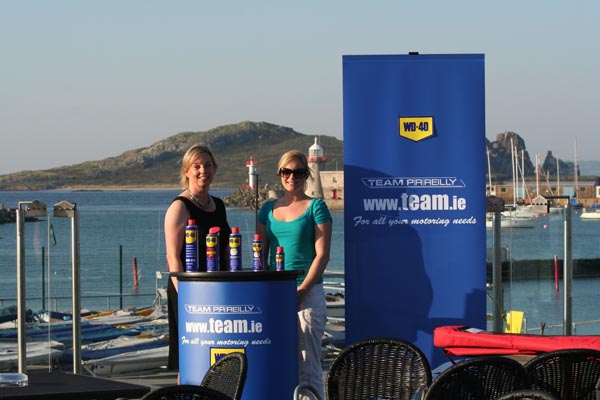
Howth Autumn League chairperson Joan Harris with Lynn Reilly of sponsors WD-40
O'Driscoll Domination of J24 Fleet Continues
The stranglehold that Flor O'Driscoll and his crew on 'Hard on Port' from the Royal St.George Yacht Club seem to have on the Irish J/24 Class was maintained with yet another win, this time the Northern Championships hosted by Lough Erne Yacht Club on August 7th/8th, writes Graham Smith.
After a slow start, with a 4th and 6th in the first two races, the Dun Laoghaire boat showed her transom to the other 11 boats in the fleet over the remaining four races in varied wind conditions. The result was an emphatic win by ten points from the runner-up, J.P.McCaldin of the host club sailing 'Jamais Encore'.
Class President Robin Eagleson sailed so consistently on his veteran 'Luder Too' that he tied on points with 'Jamais Encore' and only lost out on a countback, an impressive result considering a 30-year gap in the boats' ages. Third overall and winning the Silver Fleet award for the older J/24s was just reward for an outstanding series.
Current National Champion Mickey McCaldin ('Murder Picture') was consistently in the top six but never really got going and had to settle for 4th overall while the same could be said of Brian McDowell's 'Scandal' from Malahide in 5th place. 'Javlin' (Stan Bradbury from Lough Ree YC) started the event with a bang, recording a 1st and 2nd in the opening races, but two OCSs later on put paid to their chances.
Having already won the Western Championships at Lough Ree in mid-June and an impressive 2nd overall in Class 3 at the ICRA Nationals on Dublin Bay, Flor O'Driscoll and his crew are looking the outstanding favourites to add the national title to their year's tally.
The 2-day event takes place on September 11th/12th at Howth Yacht Club, venue for the J/24 European Championships next year. It will provide J/24 sailors, especially those from the inland lake clubs, to familiarise themselves with the tidal Howth waters before the big event in 2011.





























